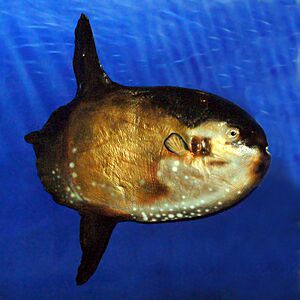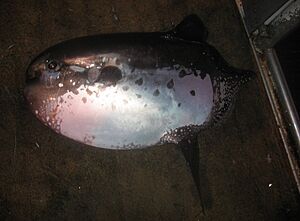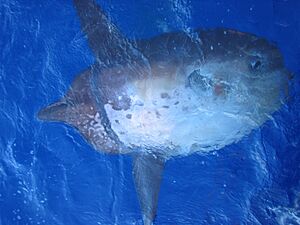Sharptail mola facts for kids
Quick facts for kids Sharptail mola |
|
|---|---|
 |
|
| A preserved sharptail mola at the National Museum of Natural History in Lisboa | |
| Conservation status | |
| Scientific classification | |
| Synonyms | |
|
Orthagoriscus lanceolatus Liénard, 1840 |
The sharptail mola (Masturus lanceolatus) is a type of mola fish. You can find it all around the world in warm, tropical and mild, temperate waters. It looks a lot like the ocean sunfish (Mola mola). But you can tell them apart by the pointy part on its tail, called a clavus. Other names for this fish include sharpfin sunfish and point-tailed sunfish. It's quite rare to see one, so scientists don't know much about its life. Recently, it has become important for commercial fishing near eastern Taiwan. This fish is the only species in its group, or genus.
Contents
Where Do Sharptail Molas Live?
Sharptail molas live all over the world in both tropical and temperate oceans. They mostly stay in the upper part of the ocean, called the epipelagic zone. This is where sunlight can reach. However, they are rarely seen at the surface. Many of those seen near the surface might be sick or have many parasites.
During the day, they spend most of their time between 5 and 200 meters (16 to 656 feet) deep. They like water temperatures above 20 °C (68 °F). But they often dive into cooler, deeper water. They might do this to find food or to avoid predators. At night, they usually stay between 100 and 250 meters (328 to 820 feet) deep. They have been seen as deep as 670 meters (2,198 feet) in the mesopelagic zone. They might even go deeper than 1,000 meters (3,280 feet). One sharptail mola with a tag in the Gulf of Mexico traveled about 10 kilometers (6 miles) each day.
What Does a Sharptail Mola Look Like?
The sharptail mola is one of the biggest bony fishes. It can grow up to 3.4 meters (11 feet) long and weigh as much as 2,000 kilograms (4,400 pounds). It has an oval-shaped body. Its forehead is smoothly rounded. Its eyes are placed more towards the front of its head than those of the Mola genus. The teeth in both its jaws are joined together, forming plates that look like a beak.
Its dorsal fin (top fin) and anal fin (bottom fin) are located towards the back of its body. The dorsal fin's base is longer than the anal fin's base. Instead of a normal caudal fin (tail fin), the dorsal and anal fins join to form a special structure called a clavus. This clavus has 18 to 20 fin rays. The rays in the middle of the clavus are supported by the last vertebra (backbone). They form a long, triangular shape. Some scientists think these rays are what's left of the tail fin from when the fish was a baby. However, not everyone agrees with this idea.
Their skin is covered with tiny bumps called dermal denticles. These are smaller than the ones on the ocean sunfish. Sharptail molas are silvery in color. The upper parts of their sides are grayish-brown to blackish. They might have faint dark spots on their sides. The dorsal and anal fins are slate gray. The clavus might have light-colored patches. This species is different from the similar Masturus oxyuropterus. It has a noticeable chin and no dip above its eyes. Also, its dorsal and anal fin bases are not the same length. Some scientists think these two types of fish might actually be the male and female of the same species.
Sharptail Mola Behavior and Life Cycle
Early scientists wondered if sharptail molas were just unusual ocean sunfish that kept their baby features. But now we know that the pointy tail part grows later, after the main tail is lost. The sharptail mola swims like other ocean sunfish. It uses its long dorsal and anal fins to move through the water. The anal fin moves more than the dorsal fin. Its small pectoral fins (side fins) move all the time to help it steer up or down. The clavus acts like a rudder to help it steer.
Young sharptail molas eat small creatures that live on the ocean floor, like annelid worms and sponges. Adult molas likely eat jellyfish, siphonophores, ctenophores, and salps. They also eat some fishes, crustaceans, and molluscs. Sometimes, sharptail molas have remoras (suckerfish) attached to their bodies or inside their mouths. In 1949, a sharptail mola near North Carolina was found with a common remora stuck inside its gill arches. This made it hard for the mola to breathe. Because of this, it ended up on the beach and was collected by fishermen.
Molas lay eggs (they are oviparous). They lay more eggs than almost any other fish. Baby sharptail molas are round. They grow large, pyramid-shaped spines on their bodies. These spines stay until they reach a stage called "Molacanthus." At this stage, their body is deep and flat, with a thin, keel-like part under their belly. This ridge is made of skin and has rows of small spines. Their skin is rough with tiny prickles. The spines eventually get smaller and disappear. They leave scars that you can see on young fish up to 70 millimeters (2.8 inches) long. Their back is dark brown, and their sides and belly are very light. Scientists believe male sharptail molas can live for about 85 years, and females can live for about 105 years.
Sharptail Molas and People
Since 2002, a festival in Hualien County, Taiwan, has promoted eating ocean sunfish. People there call it "mambo fish." Before this, only the intestines and reproductive organs were sold, and the rest of the fish was thrown away. The festival lasts for a month in April and attracts about 120,000 visitors. It even features "101 ways to eat" sunfish. Because of this, the number of sunfish caught off eastern Taiwan has greatly increased. Sharptail molas make up 90% of these catches. In 2005, 208 tons of sunfish were caught. The yearly sunfish catch was worth about one million US dollars. These fish are caught using set nets, drift nets, and longline fishing. Scientists are now studying how this increased fishing is affecting the number of sunfish in the ocean.
Discovery of a Large Sharptail Mola
On Wednesday, November 30, 2022, a 450-pound sharptail mola was found washed ashore on a beach in North Carolina. The North Carolina Museum of Natural Sciences kept the fish.




